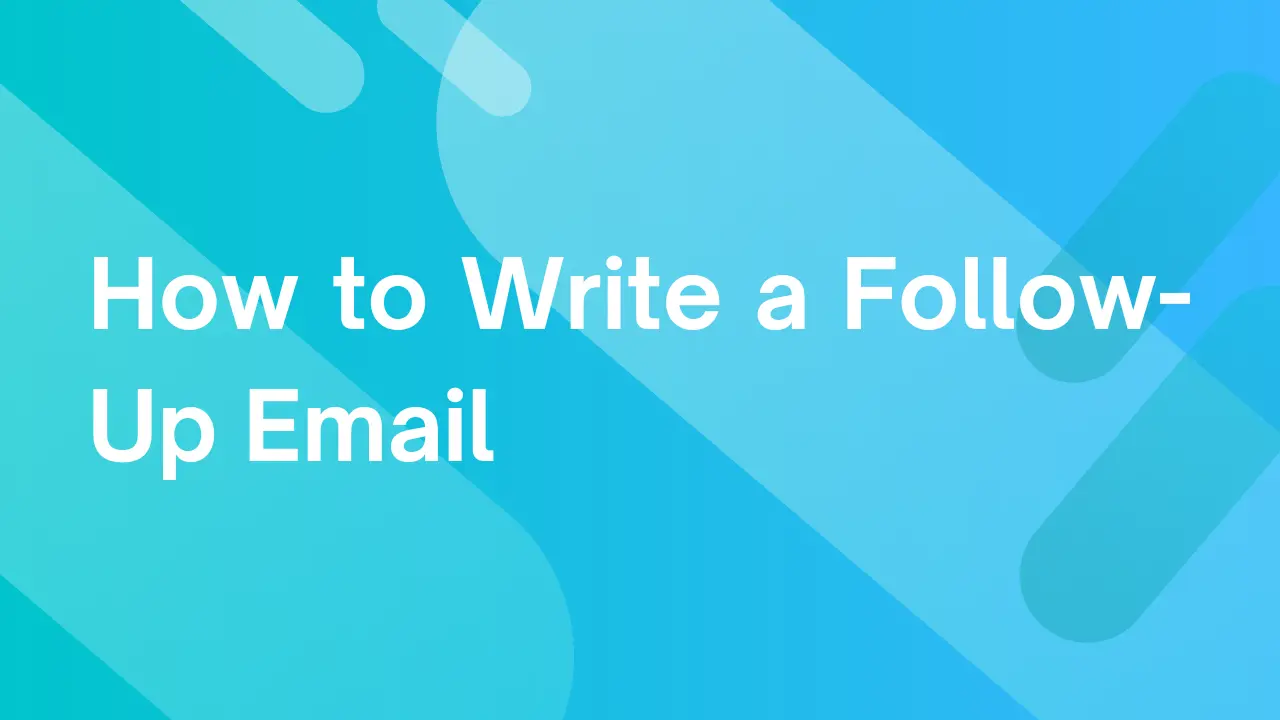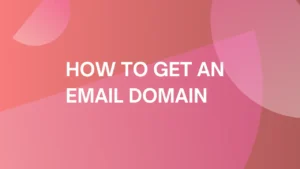
How to Write a Follow-Up Email
Following-up is an important aspect of any outreach strategy. When you write your first cold email, you want to interest the recipient and get them to engage with you.
On the other hand, when writing a follow-up email, your goal is to re-engage the recipient, increase open rates or nurture a relationship.
Effective follow-up emails that are well-timed are essential to growing your business and engaging the recipient; in fact, research shows that follow-up emails can increase response rates by up to 22%.
In this article, you will learn how to:
- Craft follow-up emails across industries
- Find templates that work for you
- Learn the psychology behind follow-up emails and when to send them
Step-by-Step Guide to Writing a Follow-Up Email
Giving a gentle nudge in the form of a follow-up email can only do you good. They serve as polite reminders to reconnect, offer additional value, or seek updates.
How you phrase your message can make all the difference in the outcome. The way you write follow-up emails can help you stand out from the batch of other contenders. Everything counts—from the subject line and greeting to a clear call to action and the way you wrap things up.
Step 1 – Define Your Objective
- Know why you’re reaching out: Are you checking in, asking for feedback, or moving the conversation forward? A clear purpose gives your email direction.
- Align your message with what you need: Make sure every sentence supports the goal you’re aiming for—whether it’s locking in a meeting or nudging for a response.
- Think about timing and context: What works after a sales call might not work after an interview. Adjust your tone and content to match the situation.
- Make it relevant to them: Keep your objective focused on what matters to the recipient. The more aligned your message is with their priorities, the more likely they’ll engage.
Step 2 – Write an Attention-Grabbing Subject Line
- Use action verbs and personalize: Start with dynamic language that sparks curiosity or conveys urgency. Whenever possible, include the recipient’s name or reference your previous interaction to make it feel personal.
- Avoid spammy words: Stay clear of terms like “free,” “urgent,” or “limited time,” as they could trigger spam filters. You can check out our spam words checker for some help on these.
- Keep it concise and clear: A subject line that’s too long might get cut off, especially on mobile. Aim for 5–7 words that clearly convey the purpose.
- Test variations: Subject lines can make or break your open rate. Don’t hesitate to test different subject lines to see what resonates best with your audience.
- Match the tone to the context: If it’s a follow-up after an interview, keep it polite and professional. For a sales email, you can afford to be more casual and upbeat.
Step 3 – Start with a Polite Greeting
Kick off your email with a greeting that fits the tone of your relationship:
- If you’re following up with someone in a formal or professional setting, go with Dear [Name].
- For a more casual connection, Hi [Name] feels natural and friendly.
Using their name makes your message more personal and helps establish a connection. When in doubt, it’s better to start on the formal side—you can always adjust your tone as the conversation evolves.
Step 4 – Reference the Previous Interaction
Start by briefly mentioning where and when your last interaction took place to give your recipient some context. Whether it was an interview, a meeting, or a quick chat at an event, referencing the previous touchpoint helps jog their memory and sets the stage for your message.
This small reminder makes it easier for the recipient to connect the dots and keeps the conversation flowing smoothly. A clear reference also demonstrates that your follow-up is thoughtful and intentional, not just another generic message.
Step 5 – Provide Value
A follow-up email is a chance to give something extra. Whether it’s new insights, helpful resources, or a quick solution to something they mentioned, showing up with value proves you’re thinking about their needs, not just your own.
When you position your message as helpful, it’s not just a follow-up—it’s a reason to engage. The more relevant and thoughtful your offer, the harder it is for them to ignore.
Step 6 – Include a Clear CTA
Don’t leave your recipient guessing—be upfront about what you want them to do next. Whether it’s scheduling a call, providing feedback, or reviewing a document, a clear call to action (CTA) helps guide the conversation forward.
Make it as easy as possible for them to respond:
- If you’re suggesting a meeting, offer a few time slots.
- If you’re requesting feedback, ask a specific question.
The easier you make it, the more likely they’ll follow through.
Step 7 – Close the Email Professionally
Wrap things up with a professional sign-off that matches the tone of your message.
- If it’s a formal follow-up, go with “Best regards” or “Sincerely.”
- For something more casual, “Warmly” or “Talk soon” can also work.
A strong closing leaves a positive impression, signalling that you value the conversation and are looking forward to hearing back.
Step 8 – Proofread and Edit
Before hitting send, take a moment to review your email. Look out for typos, grammatical errors, or awkward phrasing that could weaken your message. Make sure your tone matches the situation—polite, respectful, and aligned with the relationship you have with the recipient.
A clean, well-written email reflects professionalism and attention to detail, giving your message the best chance of success.
The 15 Best Follow-Up Email Templates
Use the below templates to get an idea of how to approach prospects depending on the situation and industry in which you operate.
Follow-up email after receiving no response (three days after the initial email)
Second follow-up email after receiving no response (four-five days after the first follow-up email)
Third follow-up email (send seven days after the second follow-up)
Follow-up email after a job interview
Sales (SaaS) – follow-up after a product demo
Real estate – follow-up after property viewing
Marketing agency – follow-up after presenting a proposal
Discovery call follow-up template
Proposal follow-up email template
Networking follow-up email template
Invoice follow-up email template
Inquiry follow-up email template
Follow-up after a referral
Follow-up after sending a free trial or sample
Follow-up on a customer feedback request
Tips on Sending Follow-Up Emails
Now that you understand the basic elements of follow-up emails, it is important to understand when and how to utilize them.
Follow the below tips to maximize the effectiveness of your follow-up emails.
When to send a follow-up email?
The timing of your follow-up email is almost as important as its quality.
Research suggests that the best time of day to send an email is between 10 AM and 11 AM on a Tuesday, as 27% of marketers surveyed in a study reported that sending an email at this time resulted in the highest reply rates.
Follow-up email psychology
To better understand the psychology of follow-up emails, we can refer to the Zeigarnik Effect. Psychologist Bluma Zeigarnik concluded that people remember uncompleted and interrupted tasks much better than the completed ones.
To that end, a follow-up email reminds the recipient that they have an incomplete action – and consequently encourages them to reply to your initial message.
A/B testing follow-up emails
Performing A/B testing is a sure way to determine the best iteration of a written piece such as an email, ad or a landing page.
Before you start sending out follow-up emails, you can run tests to find the ones that recipients best respond to.
To perform A/B testing, you can:
- Select an element of an email you wish to test (e.g. a subject line)
- Craft two different emails (one with a short and the other with a longer subject line)
- Segment your audience and send different emails to different groups
- Track metrics like open rates and response rates
- Use the better-performing version in your future follow-up efforts
Consistently testing and optimizing your follow-up emails will eventually lead to you having a follow-up template that drives better engagement.
Follow-up email sequence
Sending just one follow-up email is not enough. You want to create an email sequence to continually engage your prospects.
Multiple emails ensure you continuously engage your recipients without being too pushy.
Here’s how to do it:
- Day 1: Send your initial email.
- Day 4: First follow-up—remind the recipient of your initial message and offer additional value (e.g., a resource or a demo).
- Day 7: Second follow-up—reinforce the benefits of your offer and encourage a reply with a clear call to action.
- Day 14: Final follow-up—offer to close the conversation politely or ask if the timing is right for further engagement.
Most Successful Follow-Up Emails
The thread Most effective wording for follow up emails.. on r/Accounting reveals some real-world strategies for follow-ups that finally get a response, especially when dealing with unresponsive clients. Here’s what stood out:
1. Be Clear and Set Boundaries:
Several users recommend emails that communicate clear deadlines and consequences. Statements like “If we don’t receive X by Y, we won’t meet Z deadline” help convey urgency without being rude. These follow-ups are more effective than overly polite messages, especially for repeat offenders.
Souce: https://www.reddit.com/
2. Escalate When Necessary:
Another popular tactic is CC’ing senior managers or decision-makers on follow-ups. Involving higher-ups or clients’ management tends to speed things up by adding pressure. As one user notes, “The inclusion of their management usually creates a storm and gets results.”
3. Frame it as Their Loss: A user shares that framing the message as if the client is missing out—e.g., “Do you no longer want to proceed with this project?”—often prompts a response. This approach uses psychology to shift the conversation toward action.
Conclusion
Whether you’re trying to reconnect with a lead, nurture a relationship or follow-up after an interview, sending the right kind of a follow-up email will significantly boost your engagement.
By crafting concise subject lines, personalizing emails, providing value to the recipient and keeping it succinct, you can engage and leave an impression on your prospects.
Considering that it takes multiple follow-ups, the most important thing remains to be consistent without becoming pushy.
But if you test and optimize your emails and follow best practices, you will be sure to get noticed and elicit prompt and meaningful engagement.



